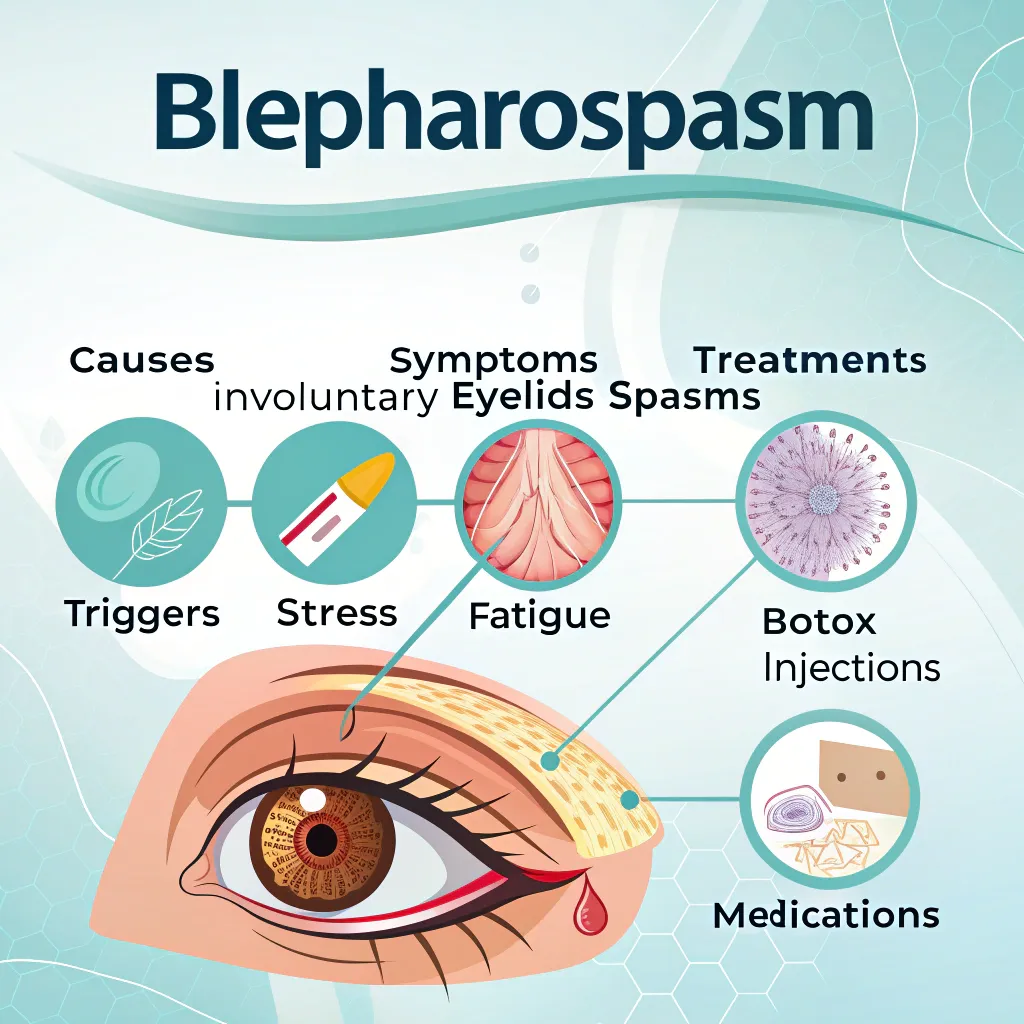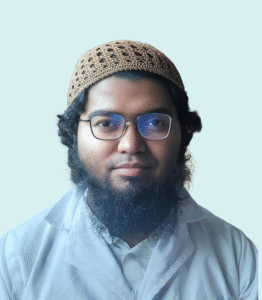Introduction
Blepharospasm, characterized by involuntary twitching, blinking, or closure of the eyelids, can significantly impact daily life. This condition, often misdiagnosed or not diagnosed, ranges from mild, infrequent spasms to forceful, frequent contractures that can cause functional blindness. This article will explore the definition, causes, symptoms, diagnosis, treatment options, and management strategies for blepharospasm to provide comprehensive information for individuals seeking to understand and address this condition.
Understanding Blepharospasm
Blepharospasm is a neurological movement disorder classified as a type of dystonia, which is characterized by involuntary muscle contractions. It primarily affects the muscles around the eyes, leading to uncontrollable and often forceful eyelid spasms. While the exact cause is often unknown, several factors can contribute to the development of this condition.
- Benign Essential Blepharospasm (BEB): This is the primary form of blepharospasm, where the cause is unknown and not associated with other diseases or syndromes.
- Secondary Blepharospasm: This form is caused by another underlying condition, such as a neurological disorder, medication side effect, or eye irritation.
Symptoms of Blepharospasm
The primary symptom of blepharospasm is involuntary eyelid twitching or spasms. These spasms can vary in intensity, frequency, and duration, and they often present with specific features:
- Increased Blinking: Individuals with blepharospasm tend to blink more frequently than normal, even when not experiencing noticeable spasms.
- Bilateral Involvement: Blepharospasm typically affects both eyes, and one-sided twitching is rare.
- Involuntary Movements: The twitching is involuntary and cannot be consciously controlled.
- Patterned Spasms: The twitching often has a pattern rather than being random.
- Severity: The degree of the spasms can range from mild twitching to complete closure of the eyes, and the duration of the spasms can vary.
- Associated Symptoms: Fatigue, sensitivity to light, dry eyes, and blurred vision may also be present. In severe cases, the spasms can lead to periods of visual disturbance due to the inability to open the eyelids.
Causes and Risk Factors
The exact cause of BEB is unknown, but it is thought to result from dysfunction within the basal ganglia. Some risk factors for blepharospasm include:
- Age: Onset is most common between 40 and 60 years of age.
- Gender: Women are more likely to be affected than men.
- Genetics: In rare cases, genetics may play a role.
- Head or Facial Trauma: Head or facial trauma can be a risk factor.
- Family History: A family history of dystonia or tremor increases the risk.
- Medications: Medications used to treat Parkinson’s disease may contribute to blepharospasm.
- Mental Health Conditions: Conditions like OCD, depression, and anxiety are linked to blepharospasm, although the causal relationship is not always clear.
- Other Factors: Fatigue, stress, bright light, wind, and air pollution can worsen symptoms. Additionally, blepharitis, dry eyes, and conjunctivitis can also be related.
- Underlying Conditions: Conditions such as Tourette’s syndrome, multiple sclerosis, and Parkinson’s disease can be associated with blepharospasm.
Diagnosis of Blepharospasm
Diagnosing blepharospasm involves a thorough evaluation by a healthcare professional. There isn’t a specific test, so diagnosis relies on:
- Physical Examination: Observing the characteristics of the eyelid spasms, their frequency, and patterns.
- Medical History: Assessing past and current eye injuries, eye conditions, and nervous system conditions.
- Ruling out Other Conditions: Ensuring that the spasms are not due to other conditions or disorders.
It’s important to distinguish between primary (essential) and secondary blepharospasm based on the patient’s history and symptoms.
Treatment Options for Blepharospasm
While there is no cure for blepharospasm, several treatment options can help manage symptoms and improve the quality of life. The primary goals of treatment are to reduce the frequency and severity of spasms, allowing individuals to perform daily tasks more comfortably.
- Botulinum Toxin Injections (Botox):
- Mechanism: Botulinum toxin injections are the first-line treatment for BEB. The toxin works by disrupting nerve signals to the muscles, causing paralysis and reducing spasms.
- Procedure: Injections are given in the eyelid protractor muscles, including the orbicularis oculi, corrugator supercilii, and procerus muscles.
- Dosage: The initial recommended dose is 1.25 to 2.5 units per injection site, with a cumulative dose not exceeding 200 units within a 30-day period.
- Frequency: The effects of Botox injections typically last for about three months, after which the procedure can be repeated.
- Effectiveness: Botox injections are effective for approximately 90% of people with blepharospasm.
- Side Effects: Common side effects include dry eyes, drooping eyelids (ptosis), double vision, and short-term blurry vision. Avoiding injection near the levator palpebrae superioris may reduce the risk of ptosis, and avoiding medial lower lid injections may reduce the risk of diplopia.
- Topical Frankincense:
- Mechanism: Frankincense, a natural gum resin from Boswellia trees, has anti-inflammatory and antioxidant properties.
- Application: Topical application of frankincense oil may provide symptom relief for some individuals with blepharospasm.
- Case Studies: Some patients have reported decreased frequency of botulinum toxin injections and significant improvement in symptoms after using frankincense oil.
- Dilution: Frankincense oil may cause burning, and diluting it with a carrier oil such as cottonseed, almond, or coconut oil is recommended.
- Research: More research is needed to understand the full effects and benefits of frankincense in treating blepharospasm.
- Other Medical Therapies:
- Oral Medications: While not typically as effective as Botox, oral medications like benzodiazepines, anticholinergics, antimuscarinics, and dopaminergics may be used. However, these therapies often have significant side effects and lack long-term effectiveness.
- Methylphenidate: Oral methylphenidate has been used for the treatment of refractory facial dystonias.
- FL-41 Tinted Lenses: Dark sunglasses with FL-41 tint can minimize light sensitivity and reduce light-triggered spasms.
- Surgical Options:
- Myectomy: Surgical myectomy is considered for patients who do not respond to or tolerate medical therapy. This procedure involves the removal of some of the muscles responsible for eyelid closure.
- Frontalis Suspension: Polytetrafluoroethylene frontalis suspension can be used as an adjunct to botulinum toxin therapy.
- Homeopathic Medicines:
- Traditional Approach: Homeopathic medicines are used based on the principle of treating “like with like,” using highly diluted substances to stimulate the body’s healing response.
- Specific Remedies: Some homeopathic remedies suggested for blepharospasm include Agaricus, Belladonna, Causticum, and Gelsemium.
- Individualized Treatment: Homeopathic treatment is individualized, and a qualified homeopath is needed to determine the appropriate remedy.
- Efficacy: The efficacy of homeopathic medicine for blepharospasm is not fully supported by modern scientific evidence.
- Other Supportive Measures:
- Eyelid Scrubs: Eyelid scrubs with baby shampoo or other non-irritating soap can minimize blepharitis that can aggravate blepharospasms.
- Stress Management: Since stress can worsen blepharospasm, incorporating relaxation techniques such as yoga, meditation, or deep breathing can be beneficial.
- Lifestyle Adjustments: Adjusting the home or work environment to accommodate vision difficulties is important to minimize risk of injury, such as falls. Avoiding activities that exacerbate symptoms, such as extended reading or driving, can also be helpful.
- Supportive Devices: Using supportive devices and services can help individuals compensate for vision trouble.
Living with Blepharospasm
Blepharospasm can significantly affect daily activities, making it difficult to read, drive, work, or perform simple tasks. The condition can also cause psychological distress. It is important to:
- Seek Professional Help: Consult an eye care specialist if you experience symptoms of blepharospasm.
- Educate Yourself: Learn about the condition and treatment options.
- Mental Support: Counseling and support from family, friends, or professionals can help manage the psychological effects of blepharospasm.
- Safety Adjustments: Know when to ask for help, such as when crossing the street or needing assistance with daily tasks.
Prognosis and Outlook
The prognosis for blepharospasm varies. Primary blepharospasm can sometimes go away spontaneously, though it is not common. Secondary blepharospasm may resolve with the treatment of the underlying cause. With appropriate treatment and management strategies, most individuals can find relief from their symptoms and improve their quality of life.
Important Considerations for Treatment
- Drug Interactions and Side Effects: Tranquilizing drug overdoses can lead to dizziness, confusion, double vision, dry mouth, and other symptoms. Botulinum injections can cause ptosis, bruises, ectropion, epiphora, diplopia, lagophthalmos, and corneal exposure.
- Qualified Professionals: Treatment should be received from experienced medical professionals to minimize side effects and complications.
- Individualized Treatment: Treatment plans should be tailored to individual needs and circumstances.
Enhanced FAQ
Q1: What exactly is blepharospasm?
A1: Blepharospasm is a neurological condition that causes involuntary muscle twitches, spasms, or closure of the eyelids. It’s considered a type of dystonia, a movement disorder.
Q2: What are the main symptoms of blepharospasm?
A2: The main symptoms include involuntary and uncontrollable eyelid twitching, increased blinking, and, in severe cases, forceful closure of the eyelids. Sensitivity to light, dry eyes, and blurred vision may also be present.
Q3: What causes blepharospasm?
A3: The cause of benign essential blepharospasm (BEB) is often unknown, but it may be due to dysfunction in the basal ganglia. Secondary blepharospasm can result from other underlying conditions. Risk factors include age, gender, genetics, head trauma, and certain medications.
Q4: How is blepharospasm diagnosed?
A4: Diagnosis involves a physical examination, a review of your medical history, and ruling out other possible causes. There is no specific test for the condition.
Q5: What are the first-line treatments for blepharospasm?
A5: Botulinum toxin (Botox) injections are typically the first-line treatment, which help reduce muscle spasms in the eyelids.
Q6: Are there any alternative treatments for blepharospasm?
A6: Yes, topical frankincense oil has shown promise in some cases for reducing symptoms and the frequency of Botox injections. Other options include oral medications, FL-41 tinted lenses, and eyelid scrubs. Homeopathic medicines may also be considered, but their efficacy is not supported by modern scientific evidence.
Q7: How effective are botulinum toxin injections for blepharospasm?
A7: Botulinum toxin injections are effective for about 90% of people with blepharospasm and typically last for about three months.
Q8: What are the side effects of botulinum toxin injections?
A8: Common side effects include dry eyes, drooping eyelids (ptosis), double vision, and short-term blurry vision.
Q9: Can blepharospasm go away on its own?
A9: Primary blepharospasm can sometimes go away spontaneously, but this is not common. Secondary blepharospasm may resolve with treatment of the underlying cause.
Q10: Can vitamin deficiencies cause blepharospasm?
A10: A small research study suggested a link between lower levels of calcium and vitamin D and BEB, but there’s no conclusive research showing that deficiencies cause blepharospasm.
Call to Action
If you are experiencing symptoms of blepharospasm, it is important to consult with an eye care specialist or neurologist for an accurate diagnosis and personalized treatment plan. Early intervention can help manage the condition and improve your quality of life.
Additional Resources
- The Benign Essential Blepharospasm Research Foundation (BEBRF): www.blepharospasm.org
- National Institute of Neurological Disorders and Stroke (NINDS): https://www.ninds.nih.gov/Disorders/All-Disorders/Benign-Essential-Blepharospasm-Information-Page
- Better Health Channel: https://www.betterhealth.vic.gov.au/health/conditionsandtreatments/blepharospasm
This comprehensive guide aims to provide valuable information and support for individuals dealing with blepharospasm. By understanding the causes, symptoms, and treatment options, you can take proactive steps to manage this condition and maintain a better quality of life.

